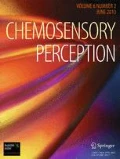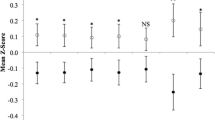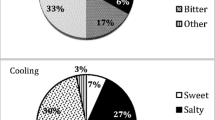Abstract
Recently, the phenomenon of thermal taste, where thermal tasters (TTs) perceive taste sensations from the application of thermal stimuli to the tongue, was described. Thermal taster status (TTS) appears to function as a marker of individual variation in orosensory perception, as TTs are more responsive to prototypical orosensory stimuli and flavor attributes in complex beverages than thermal non-tasters. The main objective of this study was to examine the influence of TTS on the relationship between stimulus temperature and orosensory perception. Propylthiouracil (PROP) responsiveness has long been used as an index of individual variation in oral sensation, as general orosensory responsiveness to a variety of stimuli associates with the ability and degree to which individuals perceive PROP's bitterness. PROP taster status (PTS), an expression of individuals' PROP responsiveness, was also examined. Perceptually equi-intense stimuli eliciting sweet, sour, bitter, and astringent sensations were presented at 5 °C and 35 °C and evaluated using time-intensity methodology. Unexpectedly, an apparent trend of TTs reporting higher maximum perceived intensities for all stimuli was not statistically significant, and an examination of individual subjects' data suggests further examination of the influence of TTS on orosensory stimuli is warranted. PROP bitterness and the perceived intensity of orosensory stimuli were not associated at either temperature; however, some differences between PTS groups were found. As previously reported, TTS and PTS interactions were not observed. Interestingly, temperature influenced the maximum intensity perceived from astringent, bitter, and sour stimuli, but not from the sweet stimulus.












Similar content being viewed by others
Abbreviations
- Alum:
-
Aluminum sulfate
- ANOVA:
-
Analysis of variance
- AUC:
-
Total area under the time-intensity curve
- DAng:
-
Angle (°) of sensation from IMax to the last recorded value
- DArea:
-
Decrease Area—area under the descending portion of the curve from Imax to the last recorded value
- DUR:
-
Total duration (s) that the sensation is rated
- FP:
-
Fungiform papillae
- gLMS:
-
Generalized labeled magnitude scale
- gVAS:
-
Generalized visual analogue scale
- IAng:
-
Angle (°) of sensation increase from start to Imax
- IArea:
-
Increase Area—area under the ascending portion of the curve from start to Imax
- IDelay:
-
Initial Delay—time (s) to first response
- IInt:
-
Initial Intensity—first intensity response
- IMax:
-
Maximum intensity
- LMS:
-
Labeled magnitude scale
- MSG:
-
Monosodium glutamate
- pMT:
-
PROP medium-taster
- pNT:
-
PROP non-taster
- PROP:
-
6-n-propylthiouracil
- pST:
-
PROP super-taster
- PTC:
-
Phenylthiocarbamide
- PTS:
-
PROP taster status
- SEM:
-
Standard error
- TI:
-
Time intensity
- TMax:
-
Time (s) to maximum intensity
- TnT(s):
-
Thermal non-taster(s)
- TPRM5:
-
Transient receptor potential melastatin 5 channel
- TT(s):
-
Thermal taster(s)
- TTS:
-
Thermal taster status
References
Artz WE, Bishop PD, Dunker AK, Schanus EG, Swanson BG (1987) Interaction of synthetic proanthocyanidin dimer and trimer with bovine serum albumin and purified bean globulin fraction G-1. J Agric Food Chem 35:417–421
Bajec MR, Pickering GJ (2008a) Thermal taste, PROP responsiveness, and perception of oral sensations. Physiol Behav 95(4):581–590
Bajec MR, Pickering GJ (2008b) Astringency: mechanisms and perception. Crit Rev Food Sci Nutr 48(9):858–875
Bartoshuk LM (1993) The biological basis of food perception and acceptance. Food Qual Prefer 4:21–32
Bartoshuk LM, Rennert K, Rodin J, Stevens JC (1982) Effects of temperature on the perceived sweetness of sucrose. Physiol Behav 28(5):905–910
Bartoshuk LM, Conner E, Brubin D, Karrer T, Kochenbach K, Palcso M, Snow D, Pelchat M, Danowski S (1993) PROP supertasters and the perception of ethyl alcohol. Chem Senses 18:526–527
Bartoshuk LM, Duffy VB, Miller I (1994) PTC/PROP tasting: anatomy, psychophysics and sex effects. Physiol Behav 56:1165–1171
Bartoshuk LM, Duffy VB, Reed D, Williams A (1996) Supertasting, earaches and head injury: genetics and pathology alter our taste worlds. Neurosci Behav Rev 20:79–87
Bartoshuk LM, Duffy VB, Lucchina LA, Prutkin J, Fast K (1998) PROP (6-n-propylthiouracil) supertasters and the saltiness of NaCl. Ann N Y Acad Sci 855:793–796
Calvino AM (1986) Perception of sweetness: the effects of concentration and temperature. Physiol Behav 36:1021–1028
Clark CC, Lawless HT (1994) Limiting response alternatives in time-intensity scaling: an examination of the halo-dumping effect. Chem Senses 19:583–594
Cliff M, Noble AC (1990) Time-intensity evaluation of sweetness and fruitiness and their interaction in a model solution. J Food Sci 55(2):450–454
Cruz A, Green BG (2000) Thermal stimulation of taste. Nature 403:889–892
Damak S, Rong M, Yasumatsu K, Kokrashvili Z, Perez C, Shigemura N, Yoshida R, Mosinger B, Glendinning J, Ninomiya Y, Margolskee R (2006) Trpm5 null mice respond to bitter, sweet, and umami compounds. Chem Senses 32:253–264
Delwiche JF, Buletic Z, Breslin PAS (2001) Covariation in individuals’ sensitivities to bitter compounds: evidence supporting multiple receptor/transduction mechanisms. Percept Psychophys 63:761–776
Drake MA, Yates MD, Gerard PD (2005) Impact of serving temperature on trained panel perception of cheddar cheese flavor attributes. J Sens Stud 20:147–155
Drayna D, Coon H, Kim U-K, Elsner T, Cromer K, Otterud B, Baird L, Peiffer AP, Leppert M (2003) Genetic analysis of a complex trait in the utah genetic reference project: a major locus for PTC taste ability on chromosome 7q and a secondary locus on chromosome 16p. Hum Genet 112:567–572
Duffy VB, Davidson AC, Kidd JR, Kidd KK, Speed WC, Pakstis AJ, Reed DR, Snyder DJ, Bartoshuk LM (2004) Bitter receptor gene (TAS2R38), 6-n propylthiouracil (PROP) bitterness and alcohol intake. Alcohol Clin Exp Res 28:1629–1637
Green BG, Frankmann SP (1987) The effect of cooling the tongue on the perceived intensity of taste. Chem Senses 12:609–619
Green BG, Frankmann S (1988) The effect of cooling on the perception of carbohydrates and intensive sweeteners. Physiol Behav 43:115–119
Green BG, George P (2004) ‘Thermal taste’ predicts higher responsiveness to chemical taste and flavor. Chem Senses 29:617–628
Green BG, Hayes JE (2004) Individual differences in perception of bitterness from capsaicin, piperine and zingerone. Chem Senses 29:53–60
Green BG, Alvarez-Reeves M, George P, Akirav C (2005) Chemesthesis and taste: evidence of independent processing of sensation intensity. Physiol Behav 86:526–537
Harris WR (1996) Binding and transport of aluminum by serum proteins. Coord Chem Rev 149:347–365
Hayes JE, Duffy VB (2007) Revisiting sugar-fat mixtures: sweetness and creaminess vary with phenotypic markers of oral sensation. Chem Senses 32:225–236
Hayes J, Bartoshuk LM, Kidd JR, Duffy VB (2008) Supertasting and PROP bitterness depends on more than the TAS2R38 gene. Chem Senses 33:255–265
Hofmann T, Glabasnia A, Schwarz B, Wisman KN, Gangwer KA, Hagerman AE (2006) Protein binding and astringent taste of a polymeric procyanidin, 1,2,3,4,6-Penta-O-galloyl-β-D-glucopyranose, castalagin, and grandinin. J Agric Food Chem 54:9503–9509
Kamerud JK, Delwiche JF (2007) Individual differences in perceived bitterness predict liking of sweeteners. Chem Senses 32(9):803–810
Keast RSJ, Roper J (2007) A complex relationship among chemical concentration, detection threshold, and suprathreshold intensity of bitter compounds. Chem Senses 32:245–253
Larson-Powers N, Pangborn RM (1978) Paired comparison and time-intensity measurements of the sensory properties of beverages and gelatins containing sucrose or synthetic sweeteners. J Food Sci 43:41–46
Lee CB, Lawless HT (1991) Time-course of astringent sensations. Chem Senses 16(3):225–238
Lim J, Urban L, Green BG (2008) Measures of individual differences in taste and creaminess perception. Chem Senses 33:493–501
McBurney DH, Collings VB, Glanz LM (1973) Temperature dependence of human taste responses. Physiol Behav 11(1):89–94
Mojet J, Christ-Hazelhof E, Heidema J (2005) Taste perception with age: pleasantness and its relationships with threshold sensitivity and supra-threshold intensity of five taste qualities. Food Qual Prefer 16(5):413–423
Moskowitz HR (1973) Effects of solution temperature on taste intensity in humans. Physiol Behav 10(2):289–292
Padiglia A, Zonza A, Atzori E, Chillotti C, Calo C, Tepper BJ, Barbarossa IT (2010) Sensitivity to 6-n-propylthiouracil is associated with gustin (carbonic anhydrase VI) gene polymorphism, salivary zinc, and body mass index in humans. Am J Clin Nutr 92:539–545
Paulus K, Reisch AM (1980) The influence of temperature on the threshold values of primary tastes. Chem Senses 5(1):11–21
Peleg H, Noble AC (1999) Effect of viscosity, temperature and pH on astringency in cranberry juice. Food Qual Prefer 100:343–347
Peleg H, Bodine KK, Noble AC (1998) The influence of acid on astringency of alum and phenolic compounds. Chem Senses 23(3):371–378
Pickering GJ, Robert G (2006) Perception of mouthfeel sensations elicited by red wine are associated with sensitivity to 6-n-propylthiouracil. J Sens Stud 21:249–265
Pickering GJ, Simunkova K, DiBattista D (2004) Intensity of taste and astringency sensations elicited by red wines is associated with sensitivity to PROP (6-n-propylthiouracil). Food Qual Pref 15:147–154
Pickering GJ, Haverstock G, DiBattista D (2006) Evidence that sensitivity to 6-n-propylthiouracil (PROP) affects perception of retro-nasal aroma intensity. J Food Agric Environ 4(2):15–22
Pickering GJ, Moyes A, Bajec MR, DeCourville N (2010a) Thermal taster status associates with oral sensations elicited by wine. Aust J Grape Wine Res 16:361–367
Pickering GJ, Bartolini J-A, Bajec MR (2010b) Perception of beer flavour associates with thermal taster status. J Inst Brew 116:239–244
Porubcan AR, Vickers ZM (2005) Characterizing milk aftertaste: the effects of salivation rate, PROP taster status, or small changes in acidity, fat, or sucrose on acceptability of milk to milk dislikers. Food Qual Prefer 16:608–620
Prescott J, Swain-Campbell N (2000) Responses to repeated oral irritation by capsaicin, cinnamaldehyde and ethanol in PROP tasters and non-tasters. Chem Senses 25:239–246
Prescott J, Ripandelli N, Wakeling I (2001) Binary taste mixture interactions in PROP non-tasters, medium-tasters and super-tasters. Chem Senses 26:993–1003
Reed D, Nanthakumar E, North M, Bell C, Bartoshuk LM (1999) Localization of a gene for bitter taste perception to human chromosome 5p15. Am J Hum Genet 64:1478–1480
Riera CE, Vogel H, Simon SA, Damak S, le Coutre J (2009) Sensory attributes of complex tasting divalent salts are mediated by TRPM5 and TRPV1 channels. J Neurosci 29(8):2654–2662
Ross CF, Weller K (2008) Effect of serving temperature on the sensory attributes of red and white wine. J Sens Stud 23:398–416
Schiffman SS, Sattely-Miller EA, Graham BG, Bennett JL, Booth BJ, Desai N, Bishay I (2000) Effect of temperature, pH, and ions on sweet-taste. Physiol Behav 68:469–481
Smith AK, June H, Noble AC (1996) Effects of viscosity on the bitterness and astringency of grape seed tannin. Food Qual Prefer 7(3/4):161–166
Statistics Canada (2001) Census ethnic origin user guide. Statistics Canada catalogue no. 92-403-GIE. Ottawa. 2008
Stone H, Oliver S, Kloehn J (1969) Temperature and pH effects on the relative sweetness of suprathreshold mixtures of dextrose fructose. Percept Psychophys 5(5):257–260
Talavera K, Yasumatsu K, Voets T, Droogmans G, Shigemura N, Ninomiya Y, Margolskee RF, Nilius B (2005) Heat activation of TRPM5 underlies thermal sensitivity of sweet taste. Nature 438:1022–1025
Talavera K, Ninomiya Y, Winkel C, Voets T, Nilius B (2007) Influence of temperature on taste perception. Cell Mol Life Sci 64(4):377
Tepper BJ, White EA, Koelliker Y, Lanzara C, D'Adamo P, Gasparini P (2009) Genetic variation in taste sensitivity to 6-n-propylthiouracil and its relationship to taste perception and food selection. International Symposium on Olfaction and Taste: Annals of the New York Academy of Sciences 1170:126–139
Thakur BR, Singh RK, Handa AK, Rao MA (1997) Chemistry and uses of pectin – a review. CRC Cr Rev Food Sci 37:47–73
Trapp GA (1983) Plasma aluminum is bound to transferrin. Life Sci 33:311–316
Valentova H, Skrovankova S, Panovska Z, Pokorny J (2002) Time-intensity studies of astringent taste. Food Chem 78(1):29–37
Zhang Y, Hoon MA, Chandrashekar J, Mueller KL, Cook B, Wu D, Zucker CS, Ryba JP (2003) Coding of sweet, bitter, and umami tastes: different receptor cells sharing similar signaling pathways. Cell 112:293–301
Acknowledgements
This work was completed as part of MRB's PhD requirements at Brock University. The authors thank Lynda van Zuiden (Brock University) for assistance. The Brock University Electronics and Machine Shops are thanked for building the thermode. Dr. Barry Green (Yale University) is sincerely thanked for his assistance with the production of the thermode, and Dr. Linda Bartoshuk (University of Florida) is thanked for her guidance on scale choice and use. Anonymous reviewers are thanked for their thoughtful comments and insightful suggestions. The Natural Sciences and Engineering Research Council (NSERC), the Pangborn Sensory Science Scholarship, and the American Wine Society Educational Foundation are gratefully acknowledged for scholarship funding. GalaxoSmithKline Consumer Healthcare Division, which underwrites the Pangborn Scholarship, has no other interest in this work. An NSERC Discovery Grant (#238881) to GJP supported this research.
Author information
Authors and Affiliations
Corresponding author
Rights and permissions
About this article
Cite this article
Bajec, M.R., Pickering, G.J. & DeCourville, N. Influence of Stimulus Temperature on Orosensory Perception and Variation with Taste Phenotype. Chem. Percept. 5, 243–265 (2012). https://doi.org/10.1007/s12078-012-9129-5
Received:
Accepted:
Published:
Issue Date:
DOI: https://doi.org/10.1007/s12078-012-9129-5




